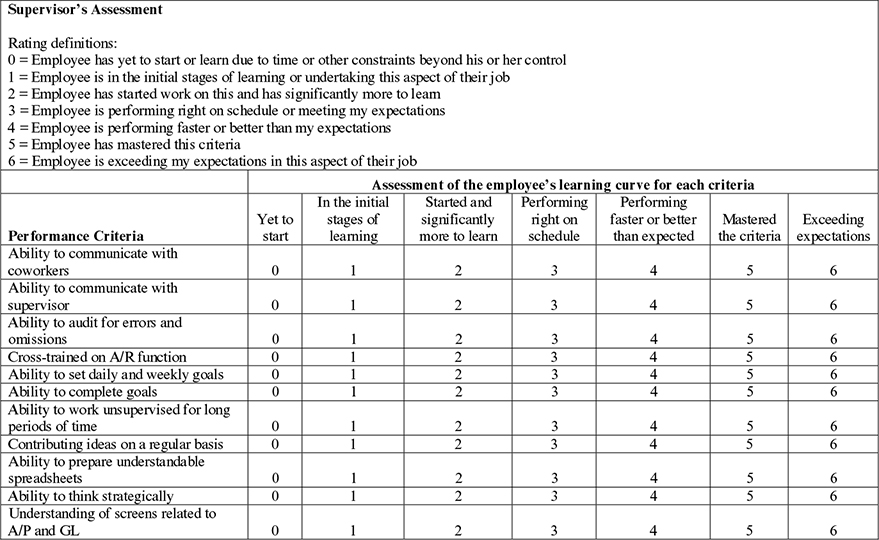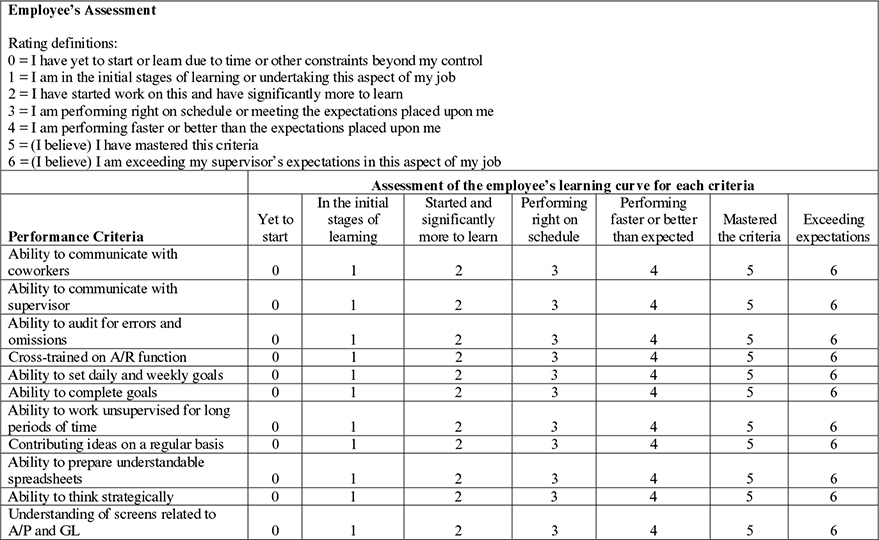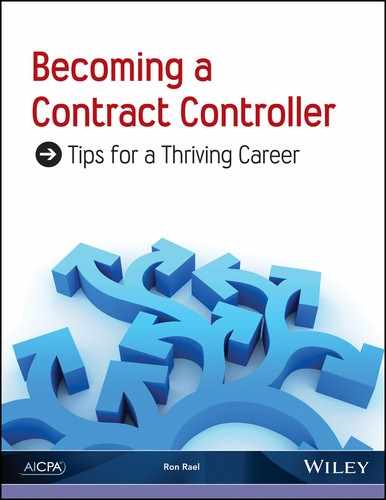Appendix A
Best Practice Tools
Best Practice: Learning Curve Performance Evaluation
This tool is to be used for evaluating an employee’s performance on a Learning Curve basis. The ratings shown are designed to highlight the employee’s current status on mastering the critical aspects of their job.
The tool fosters a dialogue about expectations with the employee because it highlights misunderstandings or miscommunications about the skills and abilities necessary to be a valuable employee.
INSTRUCTIONS
In the Performance Criteria column, list the specific skills, responsibilities, or duties that the employee must master in order to be successful in the position. Be sure to refer to the employee’s latest Position Description and update the PD as needed.
Complete the Supervisor’s Assessment page by circling the appropriate learning curve measurement for each Performance Criteria. Be sure to think carefully about all the elements of that skill, including special nuances. Be sure to consider whether the employee has consistently demonstrated the ability to fulfill the Performance Criteria since the last evaluation.
Provide the Employee’s Assessment page to employees and ask them to complete it, focusing on where they see themselves on the learning curve for each Performance Criteria.
Compare the differences between your assessment and the employee’s. Be prepared to discuss all discrepancies, especially those that are significant (i.e., vary by more than one point).
In the face-to-face evaluation meeting, ensure that the employee fully understands what you expect of them in each Performance Criteria.
Discuss and describe any new Performance Criteria that will enable the employee to grow and develop.
End the evaluation session with a specific Action Plan on how the employee will move up the scale on each Criterion.


Best Practice: Probing Questions
HOW TO GET TO THE REAL PROBLEM WHILE BUILDING TRUST
The consultant uses probing questions to uncover the client’s pain. You are like a doctor poking around the patient’s body. You poke and prod until the person says ouch. This is where you need to start whenever seeking a solution.
The reason you act like a doctor is because the person who needs a solution knows there is a problem and is unable to resolve it on their own. They have a goal or destination that they want to get to. Not being able to get there leaves them very frustrated, so they naturally are defensive. If you use direct questioning, you will only spark them into a defensive posture, leaving them unable to explore the real causes for their pain.
Probing questions are critical to the Controller or CFO because they
Get people to think and unlock untapped potential.
Allow people to discover their own answers, thus transferring ownership.
Mine the real experts (the employee or manager) for their gold.
Help people realize how the work they do contributes to the whole.
Help people feel fulfilled, satisfied, and valued.
Build positive attitudes and self-esteem.
Remove blocks and open people up to unexplored possibilities while inviting discovery, creativity, and innovation.
Help people envision what it will take to do what has not before been attempted.
Guide people toward where they want to go, while recognizing the value in where they have been.
Involve people in the decision-making process and generate commitment to solutions.
Generate alignment with a shared vision or desired outcome.
Encourage people to identify, clarify, and express their wants and needs.
Encourage people to take risks.
Recondition people from knowing what to think to knowing how to think.
Nurture a deeper relationship and engender trust.
Dissolve resistance to change.
Create a high-energy, high-trust environment.
Fundamentals of Probing Questions (PQs)
PQs are open-ended.
PQs ask “What” or “How” instead of “Why” or “Who.”
PQs are YOU oriented.
PQs show that the questioner is open and willing to hear the answer—whatever it may be.
PQs are framed to fit the situation and clarify what is required.
PQs help people learn through the process of answering.
PQs give the person credit for their answer whether they know something or not.
PQs cannot be answered “yes” or “no.”
PQs use a layering technique.
PQs require advanced preparation.
PQs start out general and then get specific.
Why Accountants Fail to Use Objective Questioning
For whatever reason, built into the personality structure of the person drawn to accounting is the desire to get to the bottom-line fast. So the questions we ask others to help get there are often pointed and are filled with assumptions about the situation. While this approach may seem economical and timesaving, it is rarely effective.
The following change agent skills rely heavily on probing questions:
Active listening.
Objective observing.
Testing your assumptions.
Integrative thinking.
Selling ideas.
Tenacity.
Intuition.
You start by asking questions that are general in nature and then move to more specific ones. These latter questions get you to the heart of the matter or issue. The tone of your questions needs to show that you are open to listening and desire to find the cause of the issue without specifically blaming the person you are questioning.
People naturally or habitually go for expediency rather than objectivity.
